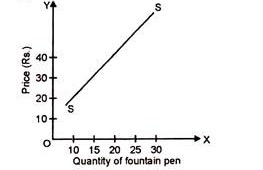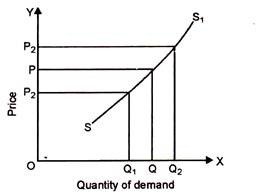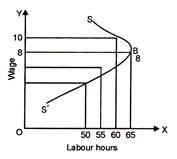Let us make an in-depth study of the Law of Supply:- 1. Introduction to the Law of Supply 2. Explanation of the Law 3. Assumption 4. Exception.
Introduction to the Law of Supply:
The law of supply reflects the general tendency of the sellers in offering their stock of a commodity for sale in relation to the varying prices.
It describes seller’s supply behaviour under given conditions. It has been observed that usually sellers are willing to supply more with a rise in prices.
The law of supply may be written as follows:
ADVERTISEMENTS:
“Other things remaining unchanged, the supply of a commodity rises i.e., expands with a rise in its price and falls i.e., contracts with a fall in its price.
In other-words, it can be said that—”Higher the price higher the supply and lower the price lower the supply.”
The law thus suggests that the supply varies directly with the change in price. So, a larger amount is supplied at a higher price that at a lower price in the market.
Explanation of the Law:
This law can be explained with the help of a supply schedule as well as by a supply curve based on an imaginary figures and data.
This can be shown by diagram as follows:
Here, in this diagram the supply curve SS is sloping upward. It suggests with the supply schedule, that the market supply tends to expand with the rise in price and vice-versa. Similarly, the upward slopping curve also depicts a direct co-variation between price and supply.
This law can be shown in this way also.
ADVERTISEMENTS:
In the figure above OX axis shows quantity of demand and OY axis shows price. SS1 line is the line of supply when the price of the commodity is OP then quantity of supply is OQ.
When the price rises from OP to OP2 and then supply also rises from OQ to OQ2. Similarly, if price is reduced from OP to OP1, then supply will reduce from OQ to OQ1.
By seeing the diagram the conclusion can be drawn that when price rises supply increases and when the price reduces the supply reduces.
Assumptions Underlying the Law of Supply:
Important assumptions of the law of supply are as follows:
1. No change in the income:
There should not be any change in the income of the purchaser or the seller.
2. No change in technique of production:
There should not be any change in the technique of production. This is essential for the cost to remain unchanged. With the improvement in technique if the cost of production is reduced, the seller would supply more even at falling prices.
3. There should be no change in transport cost:
It is assumed that transport facilities and transport costs are unchanged. Otherwise, a reduction in transport cost implies lowering the cost of production, so that more would be supplied even at a lower price.
4. Cost of production be unchanged:
It is assumed that the price of the product changes, but there is no change in the cost of production. If the cost of production increases along with the rise in the price of product, the sellers will not find it worthwhile to produce more and supply more. Therefore, the law of supply will be valid only if the cost of production remains constant. It implies that the factor prices such as wages, interest, rent etc., are also unchanged.
5. There should be fixed scale of production:
ADVERTISEMENTS:
During a given period of time, it is assumed that the scale of production is held constant. If there is a changing scale of production the level of supply will change, irrespective of changes in the price of the product.
6. There should not be any speculation:
The law also assumes that the sellers do not speculate about the future changes in the price of the product. If, however, sellers expect prices to rise further in future, they may not expand supply with the present price rise.
7. The prices of other goods should remain constant:
Further, the law assumes that there are no changes in the prices of other products. If the price of some other product rises faster than that of the product in consideration, producers might transfer their resources to the other product—which is more profit yielding due to rising prices. Under this situation and circumstances, more of the product in consideration may not be supplied, despite the rising prices.
8. There should not be any change in the government policies:
Government policy is also important and vital for the law of supply. Government policies like—taxation policy, trade policy etc., should remain constant. For instance, an increase in or totally fresh levy of excise duties would imply an increase in the cost or in case there is fixation of quotas for the raw-materials or imported components of a product, then such a situation will not permit the expansion of supply with a rise in prices.
Exceptions to the Law of Supply or Backward-Slopping Supply Curve:
ADVERTISEMENTS:
As we have seen from the study above that supply of a commodity varies directly with its price. But in some exceptional cases where supply may tend to fall with the rise in price or tend to rise with the fall in price.
Such exceptional cases may be described as follows:
1. Exceptions about Future Price:
In this connection if the seller expects a rise in the price in future, he may withhold his stock of the commodity. He will therefore reduce his supply in the market at the present price. Similarly, if he expects a further fall in price in future, he will try to dispose of the commodity and will supply more even at a lower price.
2. Supply of Labour:
Supply of labour after a certain point, when the wage rate rises, its supply will tend to diminish. Why such situation because workers normally prefer leisure to work after receiving a certain amount of wage.
3. Rate of Interest and Savings Position:
ADVERTISEMENTS:
When there is rise in the interest rate, more savings are induced. But after a certain point of rise in the rate of interest households may tend to save less than before due to high income from the interest. In that case savings tend to decline even with a rise in the rate of interest.
From the points written above we can observe that the supply tends to fall with a rise in prices at a point. This paradoxical situation of supply behaviour is represented by a backward sloping or regressive supply curve over a part of its length as shown in the figure given below:
In this diagram SS’ shows the relationship of supply with price. Backward slopping supply curve BS ‘ part represents supply curve is bending at B. This curve is also known as an “Exceptional Supply Curve” as such a thing happens only in some exceptional cases like—labour supply or savings.
Further, in this diagram SBS’ represents a backward slopping supply curve for labour as a commodity. Here the wage rate has been regarded as the price of labour and the labour supply is determined in terms of Labour-Hours the worker is willing to work at a given wage rate. It has been observed that as wages increase, a worker might work for a lesser number of hours than before.
For example:
ADVERTISEMENTS:
When the wage rate is Rs. 5 per hour, the worker works for 50 hours per week and gets Rs. 250, when it is Rs. 6 per hour, he works for 60 hours per week and gets Rs. 360 at Rs. 8 he works for 65 hours and gets Rs. 520 and at Rs. 10, he works 55 hours and gets Rs. 550.



